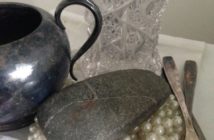ARTbop believes the definition of creativity includes the creation of food.
It’s inescapable that at the moment many in our society are not able to afford fusion food, porcini or the luxury of organic food. In fact many are finding it hard to afford food.Many in the creative arts community are not the highest earners and possessors of the biggest “disposable incomes.”
Over the years I’ve picked up a number of valuable pointers from my mother, who lived through the “Great Depression”, World War II and could recount stories of men arriving at their English village backdoor asking if “you can spare a crust and a cup of tea”. Every day my father went off to school with two lunches. I learned the value of food and how to cook on a stove made from a large tin, from “Fritz” who as a child lived through the Hunger Winter in World War II Holland and my Fourth Form new migrant, Dutch-Latin teacher who cried as we laughed that she had eaten Tulip bulbs during that same war winter. I also learned that you can thicken soup with porridge oats from a staunch and dignified Maori client who “fostered” ongoing numbers of the unwanted or the difficult. I learned from a Dutch-Indonesian friend who’d spent part of her childhood in a Japanese prison camp ( who saved every newspaper, tin and jar in the large basement of her house) the joy of good cooking and shared food. I was introduced to real Italian food by an Italian-Kiwi couple and Indian food by extended family. And then of course there is my hero Ray McVinnie whose recipes I’ve collected over the years and who can make a cabbage based soup a thing of beauty. This importance of people in the creation and sharing of food shines through in the Gennaro Contaldo cookbook, “Family Italian.”
FAMILY ITALIAN Simple, Delicious Favorites Made to Share GENNARO CONTALDO Stirling Epicure , New York, 2012
There is a smear of what looks like chocolate cake mixture across the front of this book. The hardcover is torn from the inner cover binding and this book opens out at every page and lies flat. This is a well used book. The collection of recipes and food are interwoven with family associations and lots of photographs of the chef author and his extended family. The recipes are arranged in categories of ingredients and events. There’s even a recipe for Zuppa Inglese (I can write that without referring to the book and one day I’ll tell you why). This is a book of cookable and eatable food acquired from family and friends by the same osmosis of acquisition. A lot of the recipes are affordable and nutritious and pretty easy to cook. Wouldn’t you know, I loved this book too .
Here’s one of Contaldo’s additions to your life: He says this is a recipe of his wife Liz made for her for their daughters – perfect for kids because of the veges and because it can be blended into a smooth sauce. It can be frozen in small batches and reheated if you’re in a hurry. Great for grownups too!
Penne al pomodoro e verdurine – Penne with tomato and vegetables
Serves four
4tbsp extra virgin olive oil, half an onion (grated) 1 small carrot (grated) half a zucchini (courgette) grated, 6 fresh basil leaves (optional) 500ml or two generous cups of passata (strained tomatoes-you can buy this (including good old Watties) in the local supermarkets.2 teaspoons of vegetable stock powder, salt and freshly ground black pepper. 300 grams of penne Optional – grated parmesan to serve
Heat the olive oil over a medium heat sweat (lightly cook) the grated veges for 3 – 4 minutes – the onion will soften. If you’re using the fresh basil stir it in now with the tomatoes and stock powder. Bring it to a simmer, turn the heat down to low and then cook on low for 25 minutes. Season to taste. (if you’re making this sauce for children, leave out the stock powder) Cook the penne pasta until al dente (still firm not all sloshy and slimy)
Drain it well and them add to the sauce and mix it well. Serve it immediately with a bowl of grated parmesan (if you want to add that)
If you don’t want to be bothered grating all the vegetables you can just chop them up but the cooking takes longer – its six of one and half a dozen of the other time wise.
DESTITUTE GOURMET: Stunning Food from Small Change SOPHIE GRAY Random House New Zealand, 2000, 2009 (10th anniversary edition, revised best seller)
As the title states this is a book about doing the absolute best with what you have. There are recipes transforming the ordinary into the edible wonderful. I had a go at making the “Frugal Flour tortillas” – fun to make but I think the current cost of power probably made them not so frugal and, they are so yummy I ate half of them as they came out of the pan. While the front cover is twee and slick, the inside is fabulous. You could do a lot worse than try some of these economical and yummy recipes. And again, this is a book about family, friends, society and making what you’ve got an expression of creativity.
Many of Sophie’s recipes are about “maximising” the effect and flavour of the expensive ingredients. There are magic chicken dishes which use small amounts of chicken meat and a super-sized version of a sausage roll that creates the basis of a filling meal. Her Bean and Sausage Casserole, “maximises the lovely sausage flavour while using only a few sausages.” Of course the sausages Sophie suggests you use are “real” sausages.
Bean and Sausage Casserole
Serves Four
3 good flavoursome sausages, 1 chopped onion, 2 big chopped carrots, 1 tablespoon (tbsp) flour, 1 x 400 gram can of baked beans, 1 cup of beef stock, 1 tbsp Worcestershire sauce, 1 tbsp brown sugar, 1 teaspoon (tsp) whole grain mustard, salt and pepper.
Heat the frying pan until hot, prick the sausages all over and fry quickly until they brown on the outside. Take them out and them saute (lightly fry) the onion and the carrots – the onion will go clear and golden, add in the flour, the baked beans and stir well. Add the stock, Worcestershire sauce, brown sugar and mustard. Slice the sausages and put back into the pan. Season to taste and simmer until the sauce has thickened and the sausages are thoroughly cooked. Serve with buttery mash (you could use potatoes, kumara or a mash mix) and green vegetables.
I’ve made casseroles like this in the slow cooker as well as on the top of the “stove”. I’ve also found that they taste better the second day (as do pasta sauces).
Sophie’s book is another one I’d give to a student off to University or anyone wanting to eat creatively and well on a teeny, tiny food budget.
Kiwi minnestrone
My Japanese prison camp surviving friend produced decorated birthday cakes for my young children and gave us and them many happy times, shared with a droopy eyed and eared Beau Bassett: their family hound. What I remember most of all was her version of a rich meat and vegetable soup/stew – Minnestrone. Not a lot of meat, it was cut into the tiniest little cubes but the flavour was there. Lots of vegetables and beans. When I’ve been busy I’ve cheated. I’ve browned the meat (usually cross-cut blade steak or chopped up bacon) in olive oil in the bottom of the soup pan, chucked in coarsely chopped onion (half or a whole one depending how much soup I think I’m making). I’ve had all the root vegetables chopped and ready to throw in to brown too and I just drop those in on top of the browned meat. I have a big wooden spoon and I move the whole lot around so it doesn’t burn. When I’m happy that everything’s got “a bit of colour” I tip in a tin of some kind of tomatoes then some water and maybe a tin of rinsed chickpeas. Lots of rosemary and black pepper (and sometimes garlic chives, parsley and finely chopped cabbage) . Really busy, I’ll use a tin of Watties baked beans – there’s still something about the combination of baked beans, bacon and vegetables all sloshing round in a bowl eaten with crunchy bread and butter that really kicks off winter cold. The great thing about this kind of soup is that it can be frozen in portion sized pots to drag out in a hurry and microwave or served on a beautifully set table with the bread in a basket, the butter in a dish and a glass of red wine – you’ve got a filling lunch for friends.
Rosemary Balu. Rosemary Balu is the founding and current editor of ARTbop. Rosemary has arts and law degrees from the University of Auckland. She has been a working lawyer and has participated in a wide variety of community activities where information gathering, submission writing, community advocacy and education have been involved. Interested in all forms of the arts since childhood Rosemary is focused on further developing and expanding multi-media ARTbop as the magazine for all the creative arts in the Bay of Plenty, New Zealand.




